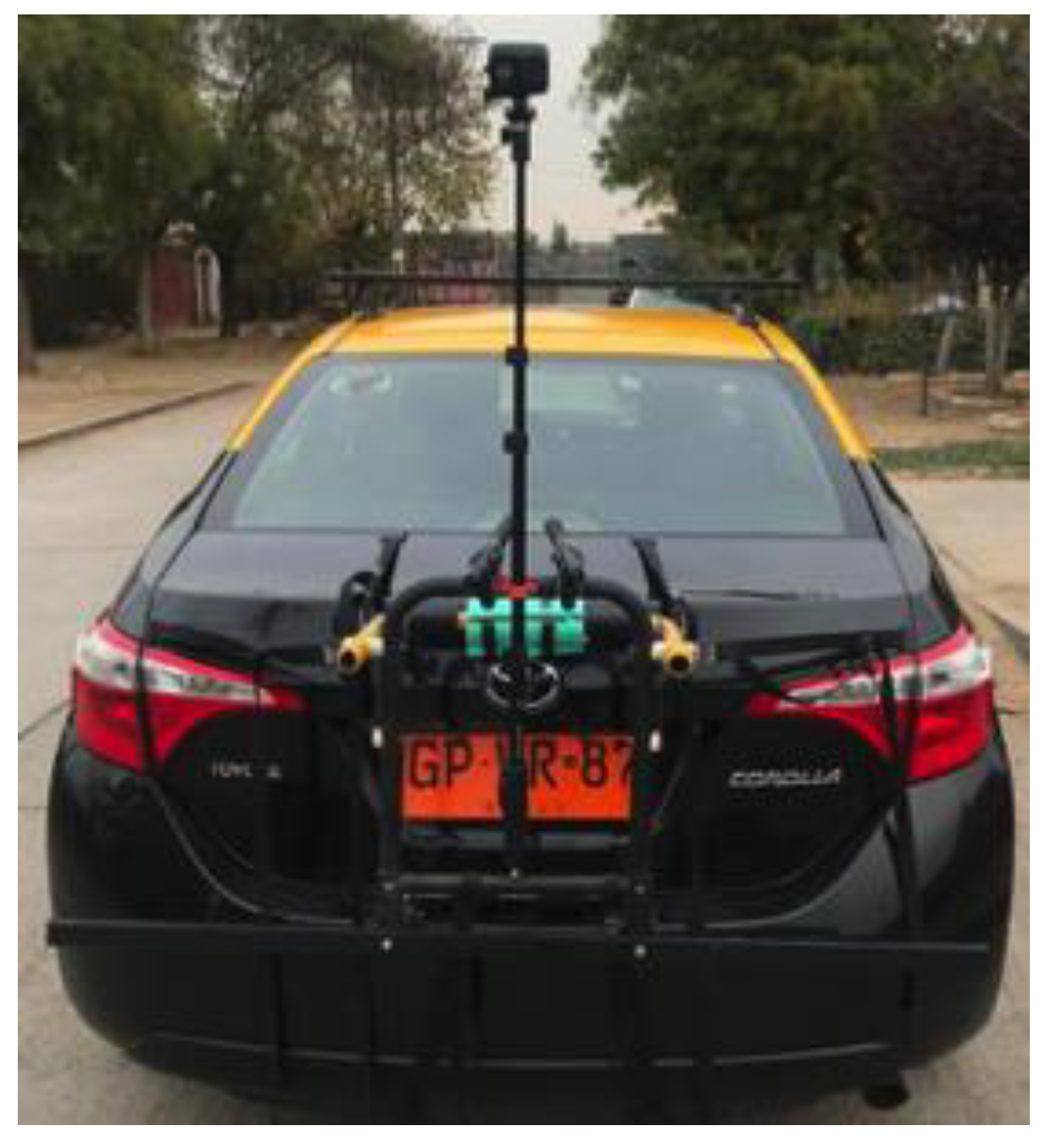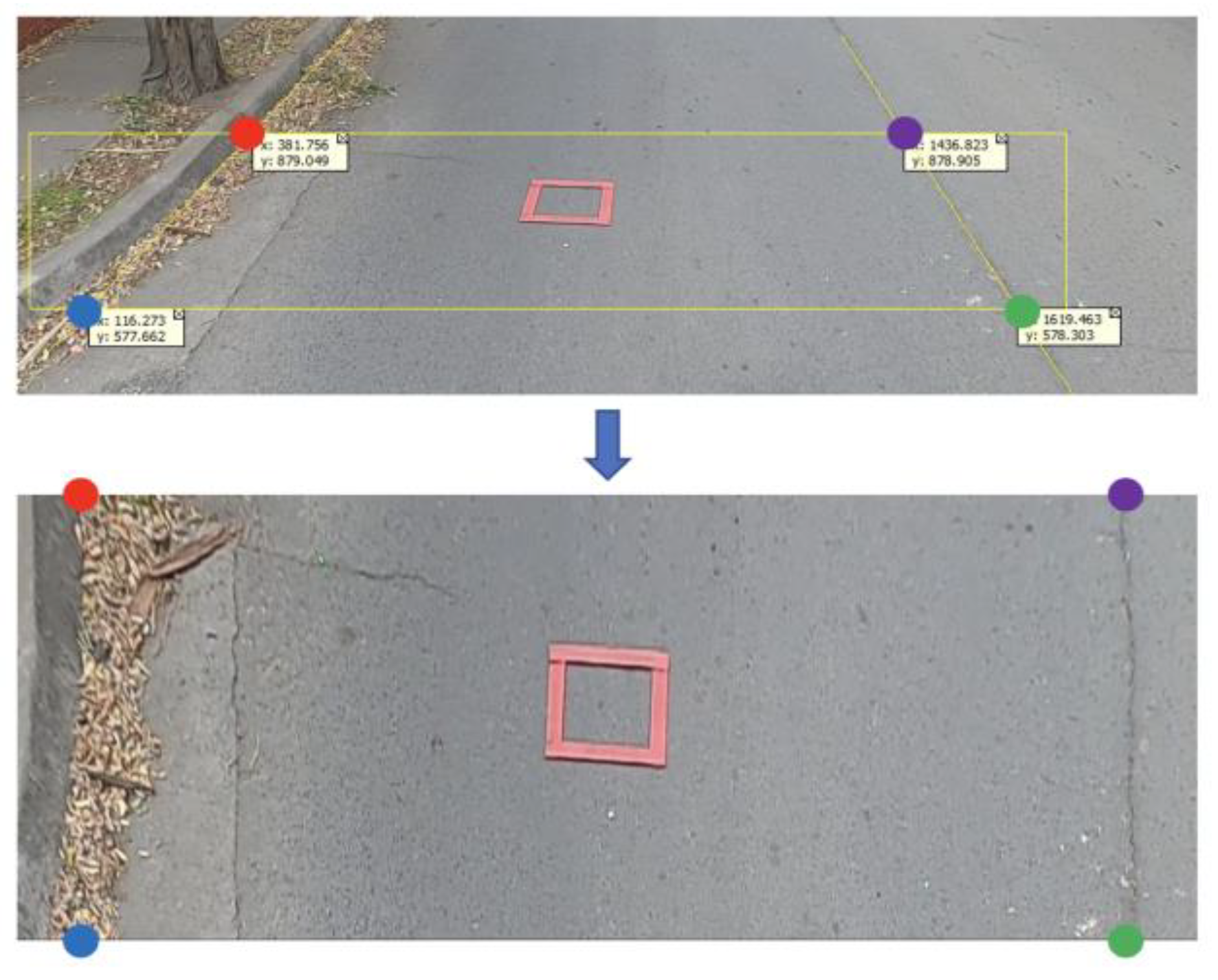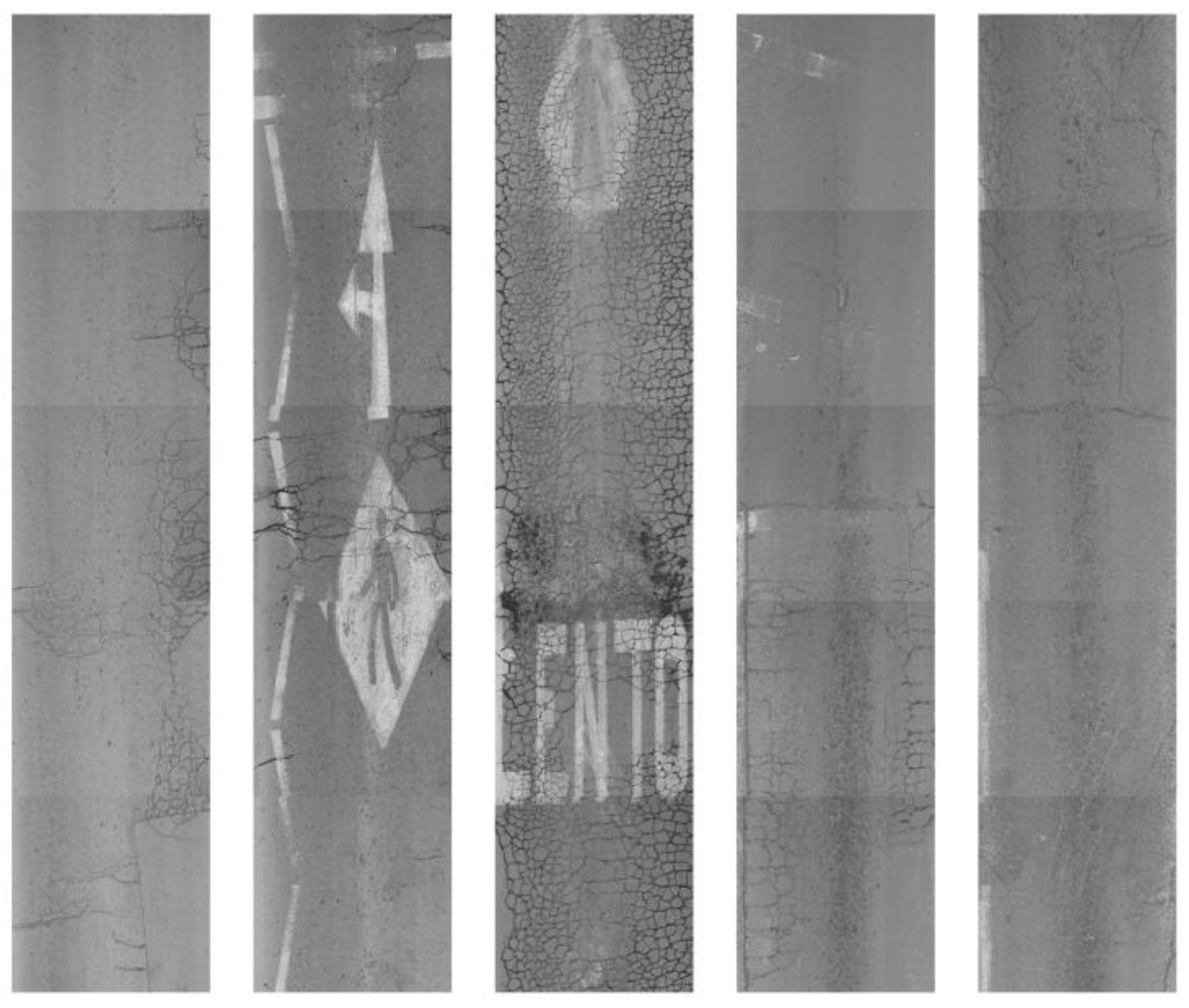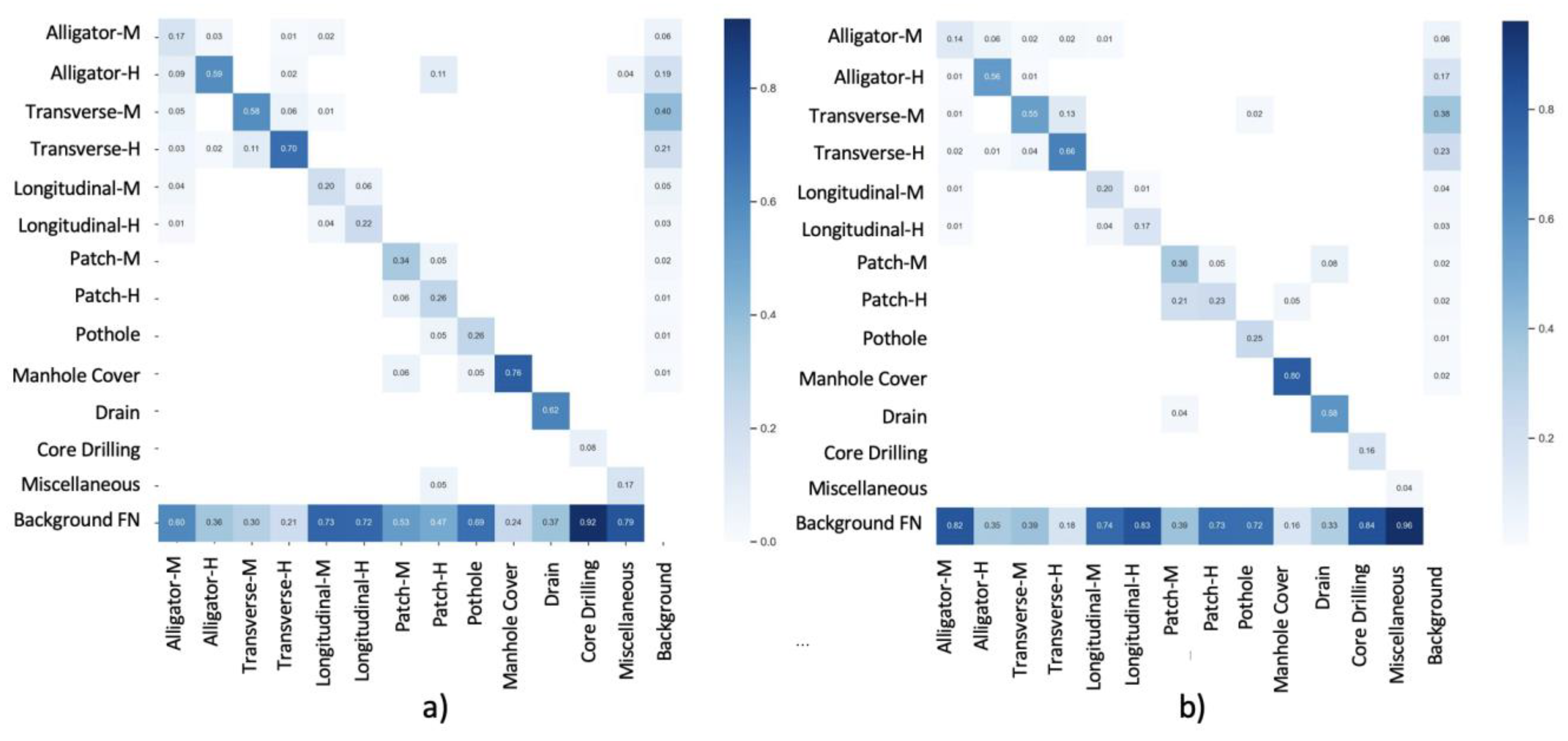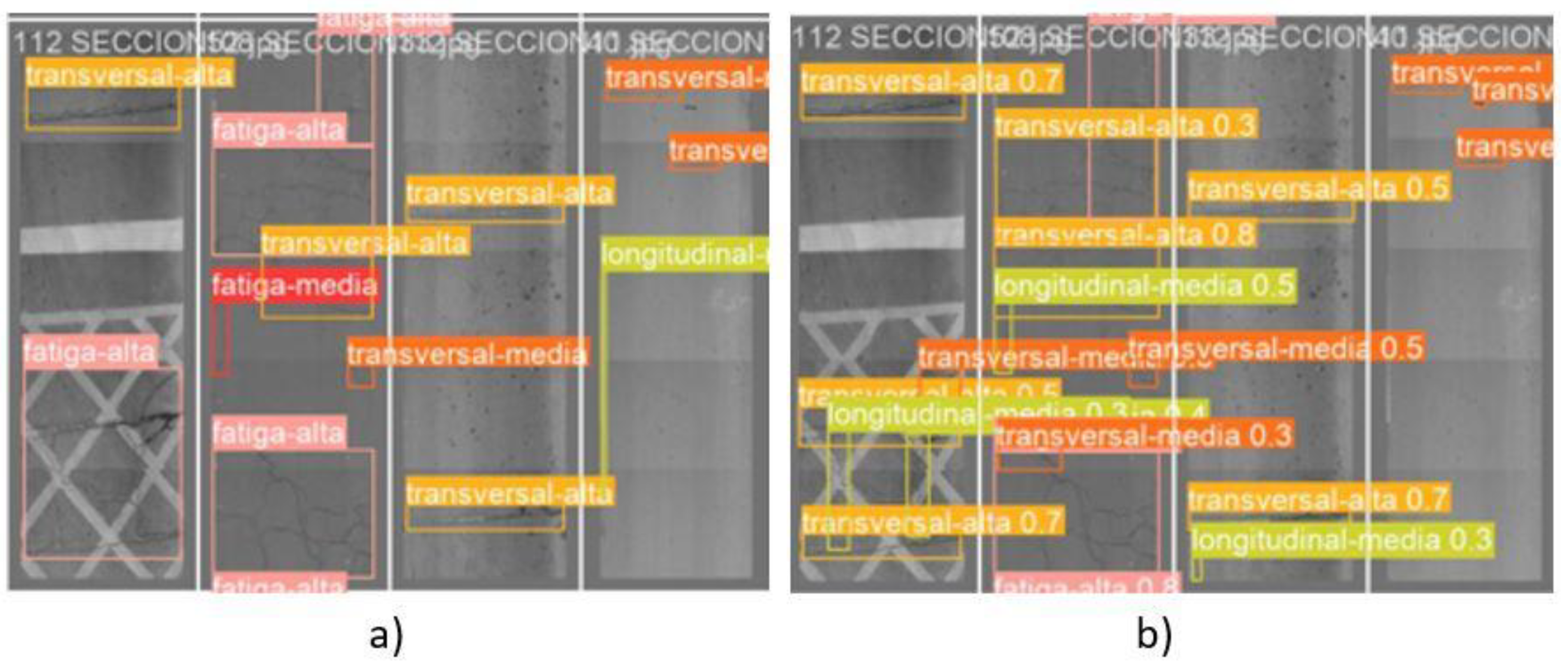1. Introduction
This study was carried out in Santiago, Chile, with the purpose of creating a database for pavement management, specifically to automate and improve the efficiency of urban pavement monitoring. Using low-cost technology, pavement images are taken and used to train a YOLO neural network to automate the detection, classification, and measurement of deterioration in urban pavements.
2. Materials and Methods
Asphalt pavement recordings were obtained by using a GoPro Hero 8 black camera mounted to a car by using a bicycle rack, as shown in
Figure 1 [
1].
By using the camera’s telemetry, frames were extracted to obtain an image of every section of the pavement.
Due to the position of the camera, the images obtained are not in plan view, and since the objective is to be able to measure distresses, a perspective transformation is applied [
2], as shown in
Figure 2. The red square was used to calibrate the transformation, since it had previously known dimensions (400 × 400 mm).
For a better understanding of the context of the distresses shown in the image, five of these images are joined together, working with a 13.55 × 2.66 m pavement section image. These images are normalized for better performance of the artificial neural network. Some examples of pavement sections are shown in
Figure 3.
Asphalt pavement images from six different municipalities were obtained, with a total length of 104.0 km and a total surface of 276.7 km2.
The total number of distresses labeled are shown in
Table 1. This was performed manually with the help of some engineering students by using the rectangle labels in VGG Image Annotator [
3].
It should be noted that the most common singularities found in pavement sections were also labeled in order to avoid confusion with distresses, such as manhole covers, drains, and core drilling.
The images are randomly split into 80% training, 10% validation, and 10% testing sets, while maintaining the same percentages for each type of distress. For both YOLOv5 and YOLOv7, training with 300 epochs each is carried out using the training and validation set, while for performance evaluation, the test set is used, i.e., images that have not been previously seen by the network.
The training was performed using a Lenovo Legion T5i Tower 6ta Gen with a NVIDIA GeForce® RTX™ 3060 12 GB GDDR6 graphic card.
3. Results
Table 2 shows the performance using both YOLOv5 and YOLOv7 with the test set. YOLOv5 and YOLOv7 took 144 and 75 h to run, respectively.
The confusion matrices are shown in
Figure 4.
An example of the results obtained by evaluating the test set in YOLOv5 is shown in
Figure 5.
4. Discussion
As shown in
Table 2, both versions of YOLO achieved a similar performance.
As for the distresses, alligator and transverse cracking demonstrated better performance (over 50%). However, longitudinal cracking, patches, and potholes are mostly undetectable.
Although the network can identify and classify the distresses, it is unreliable in terms of severity classification, which can be seen in the diagonal of the confusion matrices in
Figure 4.
Finally, YOLO was originally trained with the COCO dataset, in which objects are clearly defined, unlike distresses, where different observers might classify cracks differently.
5. Conclusions
In conclusion, there is no significant difference between the performances of the different YOLO versions. However, YOLOv7 took about half the time it took to train YOLOv5, which is a significant difference.
The pavement distresses that can be found with these results are alligator and transverse cracking; the network developed in this investigation may be useful for the detection of manhole covers and drains.
Author Contributions
Conceptualization, A.O.-L.; methodology, A.O.-L., P.G.-C. and H.A.-C.; algorithm application, P.G.-C. and H.A.-C.; validation, P.G.-C. and H.A.-C.; formal analysis, P.G.-C., A.O.-L. and H.A.-C.; resources, A.O.-L.; data curation, P.G.-C.; writing—original draft preparation, P.G.-C.; writing—review and editing, A.O.-L.; supervision, A.O.-L. and H.A.-C.; project administration, A.O.-L.; funding acquisition, A.O.-L. All authors have read and agreed to the published version of the manuscript
Funding
This research was funded by ANID Fondecyt Project 11201150. Chilean government.
Institutional Review Board Statement
Not applicable.
Informed Consent Statement
Not applicable.
Data Availability Statement
Data are available on request from the corresponding author.
Conflicts of Interest
The authors declare no conflict of interest.
References
- Venegas, J. Desarrollo de Una Metodología de Utilización de Cámaras de Bajo Costo Para la Evaluación de Pavimentos Urbanos; Technical report Anid Fondecyt 11201150; Chilean Government: Santiago, Chile, 2022. [Google Scholar]
- Rozas, D. Validación de Metodología Experimental Para la Medición de Deterioros Superficiales en Pavimentos Urbanos a Partir de Imágenes Recopiladas por Instrumentos de Bajo Costo; Technical report Anid Fondecyt 11201150; Chilean Government: Santiago, Chile, 2022. [Google Scholar]
- Dutta, A.; Zisserman, A. The VIA Annotation Software for Images, Audio and Video. In Proceedings of the 27th ACM International Conference on Multimedia, Nice, France, 21–25 October 2019; pp. 2276–2279. [Google Scholar] [CrossRef]
| Disclaimer/Publisher’s Note: The statements, opinions and data contained in all publications are solely those of the individual author(s) and contributor(s) and not of MDPI and/or the editor(s). MDPI and/or the editor(s) disclaim responsibility for any injury to people or property resulting from any ideas, methods, instructions or products referred to in the content. |
© 2023 by the authors. Licensee MDPI, Basel, Switzerland. This article is an open access article distributed under the terms and conditions of the Creative Commons Attribution (CC BY) license (https://creativecommons.org/licenses/by/4.0/).
